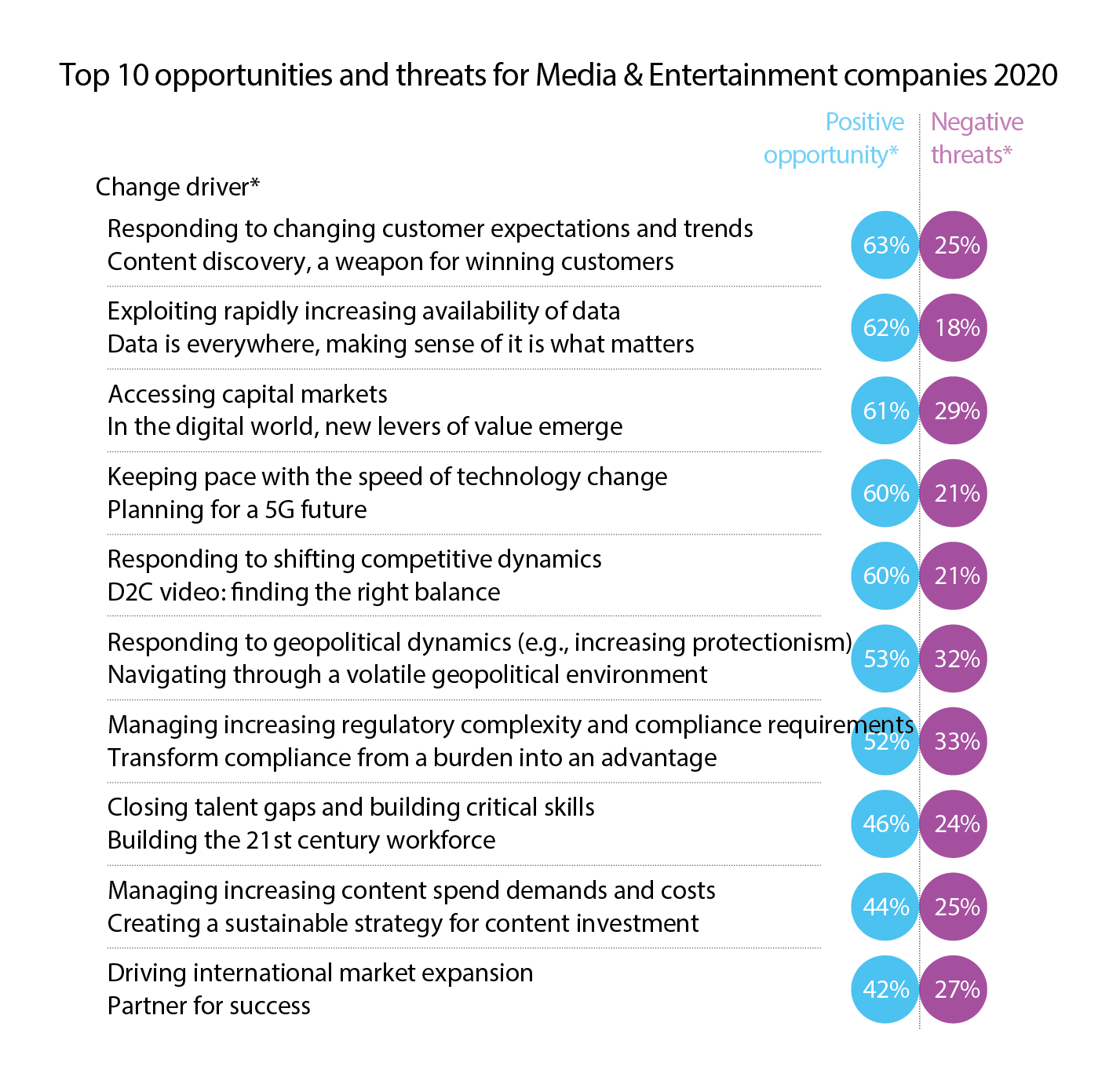Reports
M&E businesses reinventing in an age of transformation

As media and entertainment (M&E) executives navigate disruption in their industry, they are asking what they should prioritize and also what actions their peers are taking to address market realities and position for long-term success. To help answer these questions, EY surveyed over 350 industry leaders from around the world and from across the diverse range of subsectors.
Over a third of M&E executives say that without reinvention, their company will no longer exist in five years. The global survey highlights how much they understand the imperative for change. Half state that they can no longer rely on traditional business models.
Platform
Asked to identify the most impactful drivers of change on their businesses, some executives look at macroeconomic and political factors, which ebb and flow, but, nevertheless, consistently influence decision-making. However, the survey suggests that there are three drivers of change that remain constant in the disruption of the M&E industry – the dynamic, competitive landscape; the pace of technology change; and shifting consumer expectations and trends.
So many levers, so much uncertainty. Despite the need to reposition their businesses, executives remain upbeat about the opportunities that the change presents, including in areas such as competition, talent, and even regulation. If they are to capitalize on the probable benefits of change, executives must decide where to begin. They look for potential within their own businesses, but also ask what others are doing. More than one in four (28%) executives identify the need to reinvigorate their business, but admit they do not know what to prioritize. With so many levers to pull, all of which carry uncertainty and require investment, the starting point often is unclear. Despite their uncertainty, executives across the M&E industry are taking action. Their decisions reflect what their priorities are and reveal that there is no single path to reinvention. The diversity of their business models and revenue streams, as well as their relative maturity, lead to a wide array of game plans. Three ambitions that M&E companies are prioritizing above all else are – pursue operational excellence and agility; reboot innovation strategy and approach; and accelerate talent and skills development.

Priority 1: Pursue operational excellence and operational agility
In nearly all industry subsectors, the evolving nature of revenue generation – in terms of its mix, model, and contribution margin – combined with the pressing need to release capital trapped in the cost base to fund growth, is leading companies to proactively break through organizational inertia to effect change. Executives identified operating model change and improving operational delivery and execution as the top two priorities on the agenda. Getting the operating model right is considered truly transformational by almost two-thirds (63%) of those who are pursuing the initiative.
Regardless of the subsector, efficiency and effectiveness are rarely mutually exclusive.
Keep it simple. The consolidation of segments ranked highest overall (55%) for media executives aiming to streamline the operating model. Of all media subsectors, advertising and marketing services respondents were most focused (70%) on transforming the operating model through internal consolidation. The agencies are gradually bringing together vast, diverse portfolios of relatively unconnected businesses, built through multiyear acquisition programs to retire multiple sub-brands, simplify offerings, and generate efficiencies. Related to internal consolidation is the de-layering of management and the resulting increase of the spans of control for the remaining executives. Over 50 percent of all media executives surveyed rate this as a priority action, with advertising and marketing services again ranking above average (61%); film and TV producers (70%) and information services companies (60%) are also seeking to reduce management layers.
Deal with the data. Market success will largely depend on M&E companies’ ability to make the most of the data that resides in and is generated across their enterprises. Almost two-thirds of media executives see the increasing availability of data as an opportunity (62%). In some subsectors the development of data products and services is logically the top priority. Yet, many companies have not yet perfected the art of collecting, sharing, analyzing, utilizing, and protecting data. Realizing benefits from data is one of the most crucial tactics for transforming the customer experience. Broadcast, cable, and OTT networks, nearly all of which are pursuing some form of D2C relationship, see building first-party data capabilities as the top priority (56%) for increasing customer insights, innovating customer interfaces, and improving customer acquisition and retention performance. Interestingly, the least important priority for media leaders is the acquisition of third-party data (13% of respondents ranked this as a top action item).
Focus on the strategic. The modern media company is far more digital, data-driven, process heavy, and complex than ever before. Aligning with these dynamics is an ever-changing regulatory, political, tax, financial reporting, and compliance backdrop, especially as media companies extend their operating footprint around the world to far-flung jurisdictions with distinct characteristics. As these trends intensify, media executives are constantly looking for ways to meet their objectives and obligations, unburden the enterprise, and redirect management focus and resources on the most strategic areas. To optimize the execution of corporate activities that are subject to regulatory and compliance scrutiny, many media companies are centralizing functions into shared services frameworks, either insourced or outsourced, to mitigate the effects of the complex environment.
Usher in the new or build on what works. Transformational initiatives around customer targeting, product and service development, sales, distribution, and new market entry are all in play as the industry continues to evolve. Studios understand the upside potential arising from the growth in demand for content as the streaming wars go global. These companies are moving their businesses forward by prioritizing selling to new customers (69%), especially streaming-only networks with deep pockets, and upselling to existing customers (46%) that are making bold bets on D2C, and need fresh programming to support their service launches. They also view international expansion as a route to additional growth (54%). Production companies place the least emphasis on fundamental changes to their product offering (15%) – compelling content always sells for studios.In contrast, executives in many other media subsectors are focused on invigorating their product and service offerings to power the future of their business, most notably sports and live entertainment providers (57%), which are facing massive competition for ticket sales and customer attention; advertising and marketing services companies (56%), which are seeing their customers insource agency activities; and MVPDs (50%), which are dealing with cord cutting and looking at 5G wireless on the near horizon.
Priority 2: Reboot innovation strategy and approach
The industry leaders of today continue to be integral to innovation – across the industry, just 18 percent of executives see a lack of leadership buy-in as a barrier to innovation. However, there is scope to do more. Only 20 percent of M&E executives consider their corporate strategy and the vision of the CEO as a leading driver of innovation in their enterprise.
A major challenge is the conflicting pressure to deliver today while planning and investing for tomorrow, finding the balance between sustained performance and long-term innovation. Almost half of the EY survey respondents (44%) identified this as the top barrier to innovation.
Short-termism is less of an issue as companies get bigger. However, it is still a barrier for 36 percent of executives at companies with revenue of more than USD 5 billion. Coupled with 40 percent of executives, struggling to establish a clear business case for innovation initiatives or a path to a return on their investment, there is a challenge in both thinking and realizing the long-term strategy.
Companies across the media industry are deploying a full arsenal of innovation strategies in the hunt for future growth.
Priority 3: Accelerate talent and skills development
Like every industry, managing today’s workforce presents complexities for media and entertainment companies. Demographically, there are four generations in the workforce coexisting currently – boomers, Gen X, millennials, and the oldest members of Gen Z. As a greater percentage of Gen Z moves into their working years, soon to be followed by members of the yet-to-be-named youngest generation tomorrow’s workforce is expected – with its demographic spread and range of backgrounds, habits, demands, and expectations – likewise to be very different. Employee attitudes about the workplace are changing quickly. Purpose-driven, socially responsible organizations have become magnets for young talent. In this context, the need to close the talent gap and build skills is rising in importance. Across the board, 33 percent of executives identify talent management as one of the greatest drivers of change in their business, ranking higher than competition, technology disruption, or even changing customer expectations. Potentially more disconcerting is how much the talent gap is viewed negatively.
A failure to bridge the talent and skills gap continues to hold companies back, hindering their ability to adapt and compete. Among the biggest barriers to innovation in media companies are inadequate skills and training (30%). An even more significant blocker to innovation for 41 percent of M&E executives is cultural inertia. When deciding how to accelerate their talent transformation, executives face a paradox. Workforce requirements are in constant flux. The need for digital skill sets is now the norm, but changing technology continues to shift expectations and requirements. Among media executives, the preferred option for accelerating the development of talent is to upskill the existing workforce (49%). If given a free hand, more than one executive identified training as the thing they would choose for transforming their enterprise. If upskilling is the preferred option, going externally to recruit new skill sets also remains an important part of the mix and a tactic for 36 percent of media executives. The gig economy may offer a solution to this paradox. Contingent workers provide easy access to relevant skills and talent without the long-term costs of training and upskilling. Freelancers have long been a mainstay in the media industry. Of companies in the USD 250 million to USD 500 million range, 61 percent identify the gig economy as relevant to their talent strategy versus 20 percent for enterprises with revenue of more than USD 5 billion.
Outlook
Although there is much uncertainty in terms of what the future holds, there are three constants driving disruption in M&E – a dynamic, competitive landscape; technological change; and shifting customer expectations. By prioritizing three levers of action, M&E companies can address their short-term challenges, while simultaneously preparing for long-term value creation.
Operational change. The pursuit of operational excellence needs to balance efficiency and effectiveness for an M&E enterprise that will compete in a rapidly changing ecosystem. Focusing on only one of these will deliver short-term, but unsustainable, results.
Innovate by design. Innovation is a deliberate action, supported by clear structures, leadership, and processes. At the same time, innovation approaches must be multifaceted, relying on more than isolated initiatives or narrowly defined approaches.
Focus on core skills. Building an environment of continuous learning and development is essential to sustain the evolution of the enterprise. The rapid pace of change in media and entertainment makes upskilling an effective way to ensure capabilities keep pace. Based on “How Are Media And Entertainment Businesses Reinventing In An Age of Transformation?” – a report by EY.






You must be logged in to post a comment Login